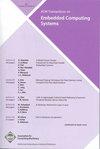在阶段执行模型中实现抢占的方法
IF 2.6
3区 计算机科学
Q2 COMPUTER SCIENCE, HARDWARE & ARCHITECTURE
引用次数: 0
摘要
阶段执行模型是一种很好的解决方案,可以抑制商业现货(COTS)多核平台增加的复杂性和竞争,例如,获取-执行-恢复(AER)模型,可预测执行模型(PREM)。这些模型将执行与对平台上共享资源的访问分开,以最大限度地减少争用。在执行阶段所需的所有数据和指令在开始执行之前被复制到核心的本地存储器中。分阶段执行模型通常与非抢占式调度一起使用,以提高可预测性。然而,在非抢占系统中,阻塞时间会降低可调度性。因此,有必要对分阶段执行模型的抢占方法进行研究。尽管如此,对于分阶段执行模型的抢占必须仔细设计以保留其执行语义,也就是说,在抢占期间对本地内存的处理变得非常重要。本文研究了在保持阶段性执行模型语义的前提下实现抢占的不同方法。据我们所知,这是第一篇从数据管理的角度探讨在分阶段执行模型中实现抢占的不同方法的论文。根据被抢占任务的本地数据处理方法的不同,介绍了两种实现执行阶段抢占的策略。启发式用于为遵循建议的抢占方法的任务集创建时间触发调度。此外,提出了一种可调度性感知的抢占启发式算法,通过只在有利于可调度性的情况下允许抢占来减少抢占的数量。对大量合成任务集进行评估,以比较提出的抢占模型彼此之间以及与非抢占版本之间的比较。此外,与非抢占和完全抢占版本相比,我们的可调度性感知抢占启发式具有更高的可调度性,并且在所有实验中都有明显的余量。本文章由计算机程序翻译,如有差异,请以英文原文为准。
Methods to Realize Preemption in Phased Execution Models
Phased execution models are a good solution to tame the increased complexity and contention of commercial off-the-shelf (COTS) multi-core platforms, e.g., Acquisition-Execution-Restitution (AER) model, PRedictable Execution Model (PREM). Such models separate execution from access to shared resources on the platform to minimize contention. All data and instructions needed during an execution phase are copied into the local memory of the core before starting to execute. Phased execution models are generally used with non-preemptive scheduling to increase predictability. However, the blocking time in non-preemptive systems can reduce schedulability. Therefore, an investigation of preemption methods for phased execution models is warranted. Although, preemption for phased execution models must be carefully designed to retain its execution semantics, i.e., the handling of local memory during preemption becomes non-trivial. This paper investigates different methods to realize preemption in phased execution models while preserving their semantics. To the best of our knowledge, this is the first paper to explore different approaches to implement preemption in phased execution models from the perspective of data management. We introduce two strategies to realize preemption of execution phases based on different methods of handling local data of the preempted task. Heuristics are used to create time-triggered schedules for task sets that follow the proposed preemption methods. Additionally, a schedulability-aware preemption heuristic is proposed to reduce the number of preemptions by allowing preemption only when it is beneficial in terms of schedulability. Evaluations on a large number of synthetic task sets are performed to compare the proposed preemption models against each other and against a non-preemptive version. Furthermore, our schedulability-aware preemption heuristic has higher schedulability with a clear margin in all our experiments compared to the non-preemptive and fully-preemptive versions.
求助全文
通过发布文献求助,成功后即可免费获取论文全文。
去求助
来源期刊

ACM Transactions on Embedded Computing Systems
工程技术-计算机:软件工程
CiteScore
3.70
自引率
0.00%
发文量
138
审稿时长
6 months
期刊介绍:
The design of embedded computing systems, both the software and hardware, increasingly relies on sophisticated algorithms, analytical models, and methodologies. ACM Transactions on Embedded Computing Systems (TECS) aims to present the leading work relating to the analysis, design, behavior, and experience with embedded computing systems.
 求助内容:
求助内容: 应助结果提醒方式:
应助结果提醒方式:


